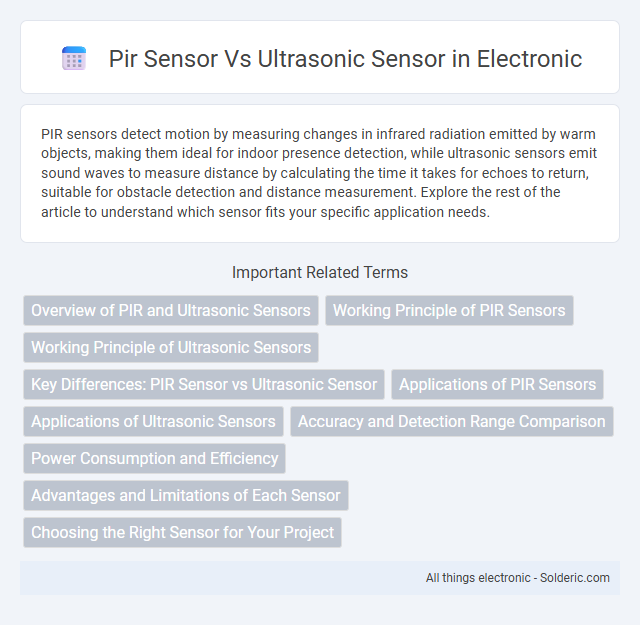PIR sensors detect motion by measuring changes in infrared radiation emitted by warm objects, making them ideal for indoor presence detection, while ultrasonic sensors emit sound waves to measure distance by calculating the time it takes for echoes to return, suitable for obstacle detection and distance measurement. Explore the rest of the article to understand which sensor fits your specific application needs.
Comparison Table
| Feature | PIR Sensor | Ultrasonic Sensor |
|---|---|---|
| Function | Detects motion via infrared heat from humans or animals | Measures distance using ultrasonic sound waves |
| Range | Typically 5-12 meters | Typically up to 4-5 meters |
| Accuracy | Motion detection with no precise distance measurement | Accurate distance measurement within cm range |
| Power Consumption | Low power usage | Moderate power consumption |
| Cost | Generally low cost | Moderate cost |
| Environment Sensitivity | Affected by temperature and obstacles blocking IR | Can detect objects regardless of light but affected by soft materials and noise |
| Typical Applications | Security systems, automatic lighting, human presence detection | Obstacle avoidance, distance sensing, robotics, level measurement |
Overview of PIR and Ultrasonic Sensors
PIR (Passive Infrared) sensors detect motion by sensing changes in infrared radiation emitted by warm objects, commonly used in security systems and automatic lighting. Ultrasonic sensors measure distance by emitting high-frequency sound waves and calculating the time it takes for the echo to return, frequently applied in robotics and object detection. Both sensors offer unique advantages: PIR sensors excel in energy efficiency and detecting human presence, while ultrasonic sensors provide precise distance measurement and operate effectively in various lighting conditions.
Working Principle of PIR Sensors
PIR sensors detect infrared radiation emitted by warm objects, primarily human bodies, by measuring changes in heat levels within their field of view. Unlike ultrasonic sensors that emit sound waves and measure their reflection time to detect distance, PIR sensors rely on thermopile detectors to sense variations in infrared energy. Your choice of a PIR sensor is ideal for motion detection applications where heat signature recognition is critical and non-contact sensing is preferred.
Working Principle of Ultrasonic Sensors
Ultrasonic sensors operate by emitting high-frequency sound waves and measuring the time it takes for the echoes to return after bouncing off an object. This time delay is converted into distance data using the speed of sound, enabling precise detection of object proximity and movement. Your application benefits from ultrasonic sensors when accurate distance measurement and detection in various lighting or environmental conditions are essential.
Key Differences: PIR Sensor vs Ultrasonic Sensor
PIR sensors detect infrared radiation emitted by warm objects, making them ideal for motion detection based on body heat, while ultrasonic sensors emit sound waves and measure their reflection to detect objects and distance. PIR sensors excel in energy efficiency and are commonly used in security and lighting systems, whereas ultrasonic sensors provide precise distance measurement and are suited for obstacle avoidance and level detection. Your choice depends on the need for thermal motion sensing or accurate spatial measurements in your application.
Applications of PIR Sensors
PIR sensors are widely used in security systems, automatic lighting controls, and energy-saving devices by detecting human motion through infrared radiation changes. These sensors excel in indoor environments such as offices, homes, and commercial buildings, where presence detection triggers alarms or activates lights. Your choice of a PIR sensor is ideal for cost-effective, low-power motion detection in applications requiring simple on/off responses without precise distance measurements.
Applications of Ultrasonic Sensors
Ultrasonic sensors are widely used in industrial automation for object detection, level measurement, and proximity sensing due to their ability to operate effectively in harsh environments and detect transparent or irregularly shaped objects. These sensors find applications in automotive systems, such as parking assistance and collision avoidance, where precise distance measurement is critical. In robotics, ultrasonic sensors enable obstacle detection and navigation, enhancing the functionality and safety of autonomous devices.
Accuracy and Detection Range Comparison
PIR sensors detect infrared radiation from warm objects with high accuracy in short to medium range, typically up to 10 meters, making them ideal for motion detection in security systems. Ultrasonic sensors emit sound waves to measure distance accurately over longer ranges, often exceeding 30 meters, suitable for obstacle detection and level measurement. Your choice depends on whether you need precise presence detection with PIR or extended distance measurement with ultrasonic technology.
Power Consumption and Efficiency
PIR sensors consume significantly less power, often operating in the microampere range, making them ideal for battery-powered applications requiring low energy usage. Ultrasonic sensors, which emit sound waves and require continuous signal processing, typically draw more current, impacting overall efficiency in energy-sensitive systems. Your choice between PIR and ultrasonic sensors should consider the trade-off between power consumption and detection range or accuracy based on your project's energy efficiency needs.
Advantages and Limitations of Each Sensor
PIR sensors offer low power consumption and effective motion detection by sensing infrared radiation, making them ideal for security and energy-saving applications, but their detection range and sensitivity are limited to warm-bodied objects. Ultrasonic sensors provide precise distance measurement and object detection through sound waves, performing well in dark or obstructed environments, though they consume more power and can be affected by environmental noise. Choosing the right sensor depends on your specific needs, such as the required detection type, range, and environmental conditions.
Choosing the Right Sensor for Your Project
PIR sensors detect motion by measuring infrared radiation changes, making them ideal for detecting human presence with low power consumption and cost-effectiveness, especially in security and lighting systems. Ultrasonic sensors use sound waves to measure distance and detect objects, providing precise ranging capabilities suitable for robotics and obstacle avoidance applications. Your choice depends on whether you prioritize motion detection with energy efficiency (PIR) or accurate distance measurement and object detection (ultrasonic).
pir sensor vs ultrasonic sensor Infographic

 solderic.com
solderic.com